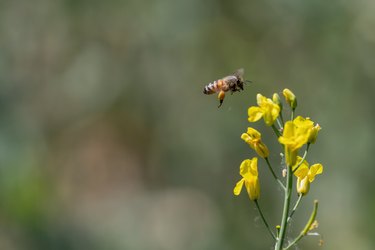
To many people, pollen is just one of the parts of a flower; to allergy sufferers, it's the enemy. Knowing where pollen is located on a flower can be useful for a few reasons. First, it helps you understand and appreciate the pollination process that's responsible for growing so much of the food we eat. Being able to find pollen is also important if you bring lilies into your home because removing the pollen early can prevent it from causing stains and triggering allergies.
What Parts of a Flower Make Pollen?
Video of the Day
The stamen, anther, pistil and stigma are the parts of a flower that are most closely involved in pollination. The stamen is the male part of a flower's reproductive system, and the pistil is the female part.
Video of the Day
The pistil is located in the center of the flower, and its topmost part is called the stigma. Many flowers have visible stamens, which look like thin filaments that surround the pistil. At the top of each stamen is an anther, a saclike structure where pollen is produced. Different plants have different numbers of stamens; often, a flower will have the same number of stamens that it has petals.
It's not as easy to spot pollen-producing anthers with the bare eye when you're looking at composite flowers, like sunflowers. Composite flowers are composed of both ray flowers (the plant's colorful petals) and disk flowers, which make up the round center of the plant. Disk flowers are composed of many tiny florets, each with its own complete reproductive system, including anthers and stigmas.
Pollen's Role in Flower Reproduction
Pollen from the anther of a flower must be transferred to a plant's stigma in order for the plant to produce fruit or seeds. Pollinators – a category that includes bees, butterflies, beetles and hummingbirds – make this process happen. A pollinator bites down on the anther of a flower or brushes up against it. Pollen is transferred to the pollinator's body. When that creature visits another flower, the pollen brushes against that flower's stigma.
When an insect or other pollinator carries pollen from one flower to a flower of a different species, this process is called cross pollination. Self-pollination occurs when the stamen of a flower is transferred to that same flower's stigma or to another flower on the same plant. Sometimes, the wind creates self-pollination by blowing pollen from the anther of a flower onto its stigma.
Removing Pollen From Lilies
With most flowers, it's not feasible to remove all the pollen before you bring them home. Lilies are the exception, as it's pretty simple to remove pollen from these blooms. You'll certainly want to remove the anthers if anyone with a sensitivity to pollen lives in or visits your home. But you should still get rid of the pollen from these flowers even if no one with pollen allergies lives in your home because bright yellow pollen dust will eventually drop from the anthers and can stain your fingers and any fabric on which it lands. Removing the pollen may also help your lilies last longer.
The easiest way to remove pollen is to use your fingers. Wait until the lilies start to bloom and then simply pull off the bulbous tips of the stamen surrounding the pistil at the center. If you buy a bouquet of lilies from a florist, you can probably skip this step. The pollen-producing anthers may already be removed for you.
- American Museum of Natural History: Parts of a Flower
- Smithsonian Gardens: The Why, What, When, Where, Who, How of Pollination
- University of California Master Gardeners: What is Pollen?
- U.S. Forest Service: Plant of the Week: Common Sunflower (Helianthus annuus L.)
- J Schwanke's Life In Bloom: Removing Lily Pollen